I don’t fish. My rights under natural law do not extend to harming any sentient creature, except in the case of self defense. I’m still troubled by the memory of the beautiful adult river otter I ran over with my truck and trailer, while passing a slow driver on the way to Lake Owen this past summer. I was the unconscious one.
I know, I’m in the minority, and you might wonder why I would introduce an article about the great work the Southeast Wisconsin Trout Unlimited organization has been doing for almost 50 years by reflecting on the nature of fishing. I’m just being honest. I love fish, especially brook trout, and recognize that the Scuppernong River is potentially an ideal place for “brookies” to live long and happy lives; that is why I am putting my energy into rehabilitating the headwaters of the Scuppernong River at The Springs.
The art of fly fishing is a classic solitary pursuit.
But fishermen/women have long recognized that they need to work together to effectively conserve, protect and restore our fisheries; hence the formation of organizations like Trout Unlimited.
TU’s guiding principles are:
From the beginning, TU was guided by the principle that if we “take care of the fish, then the fishing will take care of itself.” And that principle was grounded in science. “One of our most important objectives is to develop programs and recommendations based on the very best information and thinking available,” said TU’s first president, Dr. Casey E. Westell Jr. “In all matters of trout management, we want to know that we are substantially correct, both morally and biologically.”
The Southeast Wisconsin Chapter of TU (SEWTU) was formed in the late 1960s and, after working with them this past Saturday on the Scuppernong River, I couldn’t agree more with this sentiment expressed on their website:
You’ll be hard pressed to find a better bunch of individuals than those who comprise the rank and file of SEWTU. Friendly faces, kind words, and good fishing stories — some are even occasionally true — welcome all comers.
Since 2006, SEWTU has done many projects in the Scuppernong River Watershed, mostly on Paradise Springs Creek and the headwaters of the Scuppernong River. For example, on a cold winter day in 2008 they installed bio-logs just upstream from the Emerald Springs overlook deck and closed off the marl pit canal from the river. They did two projects on the river in 2013, installing bio-logs in the stretch between the old barn site and gaging station bridge (scroll down in these posts to view the work they did in December 2013.)
I really regretted not being on-site for the 2013 SEWTU Scuppernong River workdays. My excuse is the reference in their email notifications to the Scuppernong Creek (you may notice this on their website(s) as well), that confused me. Thanks to Ben Heussner for giving me a heads up this time. It was a pleasure to work with SEWTU members on December 6th installing bio-logs just upstream from the gaging station bridge. It was a very successful workday that completed the channel remediation efforts from the old barn site downstream to the gaging station bridge (with one caveat that we’ll get to below when we interview Larry Wirth.)
The day started when Pati and I met the Wisconsin DNR Fisheries Technicians, Joshua Krall and Ryen Kleiser, at the DNR parking area above the Hotel Spring.
We got some drinking water at the Hotel Spring and then watched Josh delivering the first load of bio-logs to the site.
Of course, The Buckthorn Man had to put in his 2-cents.
We then headed over to the main parking lot on Hwy ZZ to meet-up with the SEWTU work crew.
Here is a survey of the work area before we got started.
After reviewing the plan with Josh, I turned and got these pictures.
The workday progressed flawlessly as more SEWTU volunteers streamed in.
We soon had all of the bio-logs in place and focused on filling in brush behind them.
We accomplished an amazing amount of work before noon!
Back at the parking lot, Ray, Chris and the other chefs laid out the traditional SEWTU brat fry.
James Flagg above, talking with Mike Kuhr and with his son, Jim, below (sorry, I didn’t get in a little closer for this shot!)
During the morning Pati struck up a conversation with Larry Wirth, a long-time SEWTU member, about his role in the DNR’s decision to drain THE PONDS OF THE SCUPPERNONG (scroll down in the post linked above for some great, vintage shots of the ponds taken by Pete Nielsen). I had to talk to Larry.
At the end of the interview, Larry expressed his concern and uncertainty about the suitability of coconut hull bio-logs to macro invertebrate life, which is essential for good trout habitat. We talked to Josh Krall about the “sterility” of bio-log channels. Josh explained that channel remediation was the first, and necessary, step in the restoration and that we could/should follow up and introduce organic material on the inside of the bio-logs to provide food and habitat for macro invertebrates like caddisfly. Larry asked if there had been any studies done regarding the transition of bio-logs to a more natural stream bank and their suitability to supporting macro invertebrates.
I found this Como Lake Macroinvertebrate Survey online which states:
The two sites with biologs were not as productive as other sites and there did not appear to be other shoreline features associated with macroinvertebrate abundance or diversity.
The bio-logs upstream of the Emerald Spring were installed by SEWTU in 2008, and we can refer to them to gauge their transition to natural riverbank and the presence of macro invertebrates in their vicinity. I plan to investigate this further next spring. In general, I think it would be a good idea to line the insides of the bio-logs with some brush, logs or rocks to provide habitat for macro invertebrates. Perhaps we can do another workday with SEWTU in 2015 to focus on this next important step.
The goal of our effort is to raise as much of the Scuppernong River Watershed to the level of Class I Trout Stream as is reasonably possible. Below you can see the Scuppernong River Watershed Trout Classifications (note that no portion of the Scuppernong River in Jefferson County, where it joins the Bark River, is rated Class III or better.
As if working with SEWTU wasn’t exciting enough, Chris Mann and Austin Avellone, from the Kettle Moraine Land Stewards, joined me for a very productive workday on Wednesday, December 3, at the Ottawa Lake Fen SNA. I began clearing the buckthorn from the tamarack grove there on Monday, December 1. I was very happy to see that Andy Buchta had been busy piling the brush that Lindsay and I cut back in October. Since then, Andy has finished piling all the brush we cut there.
Here is how the tamarack grove looked on Monday morning. 


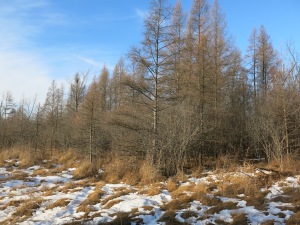
I had a fine day cutting, but it was too dark by the time I quit to take any “after” photos.
Wednesday morning was absolutely beautiful. You can see below what I accomplished on Monday and what lay ahead for the day.
Chris worked the chainsaw and Austin swung the brush cutter and we got after it!
Afterwards…
Last winter both Andy Buchta and I got horrible, blistering rashes (which I spread to Pati!), after working with the brush we cut in the buckthorn alley. I was suspicious about this tree (the one in front below) and stopped Chris to ask what it was.
He explained that it was poison sumac and advised against cutting or even touching it. That reminded me of the time that DNR Trail Boss, Don Dane, made a point of taking Lindsay and I over to an area near the boat doc at Ottawa Lake to emphatically show us what poison sumac looked like, and warn us to steer clear of it. Well, you tried Don, and it took a nasty bout with poison sumac last year to teach me a lesson. I cut a couple of poison sumacs on the north side of the Ottawa Lake Fen SNA, but no more.
Chris and Austin at work.
There is a very nice trail along the east shore of Ottawa Lake that passes beneath the campgrounds and the walk-in sites #335 and #334 and continues to the north side of the Ottawa Lake Fen SNA. The views from this trail are going to get prettier as we continue clearing the buckthorn from the trail. My dream is to eventually create a trail around the west side of the fen to connect to the boat landing on the southwest side of Ottawa Lake. I think that would be awesome!
See you at The Springs!








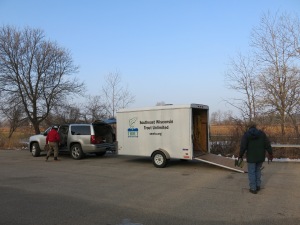















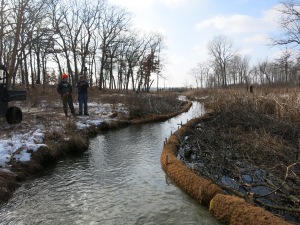



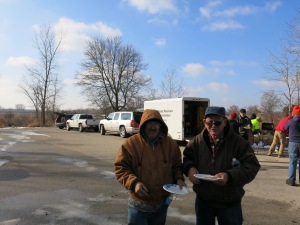

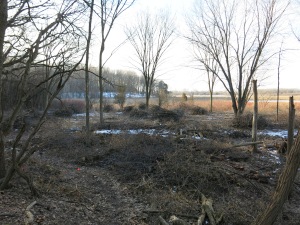










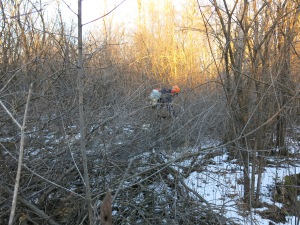




Ben Heussner provided this feedback via email regarding the suitability of the coconut hull bio-logs to support macro invertebrates: “Just one comment – the work done 10 + years ago you were describing in the video was done entirely with brush bundles. In the video you described it as “now the biologs have disappeared”. I just wanted to mention it because when planning this project we decided to go with biologs with the thought they would have a better chance at re-establishing the bed and bank for a longer time. Providing in-stream woody structure will definitely be a part of the future continuation of this project to help establish a healthy food source of macros.”
Thanks Ben
Tony Olveda let me know that the official SEWTU site is http://www.sewtu.tu.org.
The http://www.sewtu.org site is the OLD one.
Pingback: Bluff Creek West | Scuppernong Springs Nature Trail
Pingback: SEWTU: Trout Stream Therapists | The Buckthorn Man
Pingback: Watercress River | I Am The Buckthorn Man
Pingback: The Fen at Scuppernong Springs | I Am The Buckthorn Man